
Website owner: James Miller
MOMENTS, CENTER OF GRAVITY, CENTROID, MOMENT OF INERTIA, RADIUS OF GYRATION
Moment of a force. The concept of the moment of a force comes from the law of the lever, discovered by Archimedes. It corresponds to the torque exerted on a lever by a force. A lever consists of a rigid bar which is free to turn about a fixed point called the fulcrum.
Def. Moment of a force. The moment M of a force F about some fixed fulcrum is defined as

M = Fd
where d is the distance from the fulcrum to the line of action of the force. The torque produced by a force F is also defined as Fd. The two terms are synonymous. See Fig. 1a.
In Fig.1b the torque, or moment, produced by force F1 is given by F1 times its distance from the fulcrum, which is 19 feet. Thus the torque is equal to F1·19. If F1 = 7.2 lbs., the torque is 7.2·19 = 136.8 ft.-lbs.
Fig. 1b shows a system of five forces acting on a lever at varying distances from the fulcrum. Forces F1 and F2 produce a counterclockwise torque and forces F3, F4 and F5 produce a clockwise torque. The law of the lever states that in order to have equilibrium the sum of the counterclockwise torques (or moments) must be equal to the sum of the clockwise torques. If the sums are not equal there will be rotation. In the figure the sum of the counterclockwise moments is given by
ΣM1 = F1·19 + F2·16 .
If F1 = 7.2 lbs. and F2 = 9 lbs. then
ΣM1 = 7.2·19 + 9·16 = 281 ft-lbs.
The sum of the clockwise moments is given by
ΣM2 = F3·9 + F4·15 + F5·19 .
If F3 = 4 lbs., F4 = 10 lbs. and F5 = 5 lbs. then
ΣM2 = 4·9 + 10·15 + 5·19 = 281 ft.-lbs.
Computing centers of gravity. We wish now to deal with the problem of computing the location of the center of gravity, or center of mass, of a body. The center of gravity is the same as the center of mass since weight and mass are proportional. Because the concept of a center of mass doesn’t presume a gravitational field, many prefer that term. However, in developing the ideas involved we need to assume a gravitational field and will speak of the center of gravity.

In developing the ideas for computing the location of the center of gravity we will view a body as an assemblage of individual particles. The earth exerts an attraction on each individual particle of a body and the weight of a body is the sum total of all the forces on all the particles making up the body. Thus we will consider the problem of finding the location of the center of gravity for assemblages of particles in space.

Consider a steel rod resting on a pivot as shown in Fig. 2. If the pivot is directly below the center of gravity, the rod is balanced, and the sum of all the clockwise moments from particles to the right of the pivot is equal to the sum of all the counterclockwise moments from the particles to the left of the pivot. The upward force F exerted by the pivot on the rod, as shown in Fig. 3, is equal to the weight of the rod.

Now let us consider the situation in which the pivot is at the left end of the rod as shown in Fig. 4. Suppose an upward force F is exerted directly below the center of gravity and equal in magnitude to the weight of the rod. Then the rod will be balanced, no force will be exerted on the pivot, and the sum of all of the clockwise moments from the particles of the rod will be equal to the counterclockwise moment Fd produced by force F (where d is the distance from the pivot to the center of gravity, as shown in the figure). Thus if we were able to compute the clockwise moments of the particles of the rod with respect to the pivot point and knew the weight of the rod, we would then be able to compute the distance d from the pivot to the center of gravity.

Consider now a system of n point masses situated along a horizontal line, as shown in Fig. 5, conceived of as attached to a rigid weightless framework with a pivot point at the left end. Suppose the weights of the masses are w1, w2, w3, ... , wn and their distances from the pivot point are x1, x2, x3, ..., xn. Let M1 be the sum of the clockwise moments of the n masses with respect to the pivot point. Then
M1 = x1w1 + x2w2 + x3w3 + ... + xnwn
Let F be an upward force equal in magnitude to the combined weights of all the masses and located directly under the center of gravity. Then the counterclockwise moment M2 due to F is given by Fd where d is the distance from the pivot to the center of gravity. The system of masses will be balanced with the counterclockwise moment M2 equal to the sum of the clockwise moments M1 so
Fd = x1w1 + x2w2 + x3w3 + ... + xnwn
and

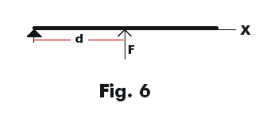
Let us now go back to the rod of Fig. 4 and write down the expression for computing the distance d. We lay an x-axis of a coordinate system along the rod with the origin at the pivot. We consider the rod to consist of an assemblage of particles m1, m2, ..., mn. The sum M1 of the clockwise moments of the particles of the rod with respect to the pivot is given by
![]()
where ρ is the density of an infinitesimal element dx and integration takes place over the length l of the rod. The weight W of the rod is given by
![]()
and

Since mass is proportional to weight, 3) can also be expressed in terms of mass.
In terms of mass it is

where x is the distance of the infinitesimal element of mass dm from the pivot.
We have considered a one-dimensional case where masses are distributed out in a line, as in a rod. The ideas are easily extended to assemblages of points in two and three-dimensional space.
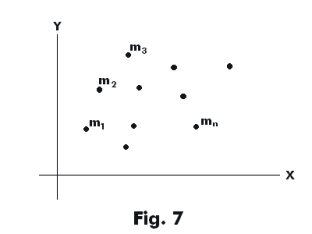
Consider a system of n point masses m1, m2, ..., mn scattered about on a horizontal plane, as shown in Fig. 7, with an x-y coordinate system superimposed on the plane. Again the point masses are conceived of as being attached to a rigid weightless framework. The masses are located at points (x1, y1), (x2, y2), (x3, y3), ... , (xn, yn) and have weights w1, w2, w3, ... , wn. The moment of mass m1 with respect to the y-axis is x1w1. Its moment with respect to the x-axis is y1w1. The sum of the moments of the n particles about the y axis is
My = x1w1 + x2w2 + ... + xnwn .
The sum of the moments of the n particles about the x axis is
Mx = y1w1 + y2w2 + ... + ynwn .
The x and y coordinates of the center of gravity of this collection of point masses is then
![]()
![]()
where W is the combined weight of the n point masses.
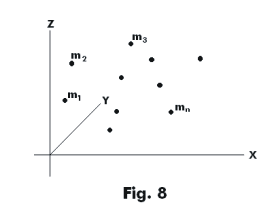
For an assemblage of point masses in three-dimensional space as shown in Fig. 8, these formulas become
![]()
![]()
![]()
where W is the combined weight of the n point masses.
The x, y and z coordinates of the center of gravity of a body in space are then given by



where integration takes place over the volume V of the body and ρ is the density of the infinitesimal element of volume dV. Expressed in terms of mass these formulas become



Def. Moment of mass about a point, line, or plane. The sum of the products of the mass of each of the particles and its distance from the point, line or plane. Tech. The integral, over the given mass, of the element of mass times its perpendicular distance from the point, line or plane. Algebraic (signed) distances are to be used in computing moments. A moment is essentially the sum of the moments of individual particles (elements of integration).
For a set of particles on a line (the x-axis), the moment Ma about a point a on the line is
![]()
where ρ(x) is the density (mass per unit length) at the point x.
For a set of particles in the plane, the moment My about the y-axis is
![]()
where ρ(x, y) is the density (mass per unit area) at the point (x, y) (if ρ is a function of x alone, then dA may be a strip parallel to the y-axis).
For a set of particles in space, the moment Mxy with respect to the x-y plane is given by
![]()
where ρ(x, y, z) is the density (mass per unit volume) at the point (x, y, z) in the element of volume dV.
James and James. Mathematics Dictionary.
Centroids. The centroid of an area or volume is the same as the center of gravity if the figure or body is homogeneous. We speak of the centroids of geometric figures and solids such circles, triangles, spheres, cubes, etc. It is customary to speak of their centroid rather than center of gravity since, being merely geometrical figures, they are not influenced by gravity.
Centroid of a plane area or figure. The coordinates of the centroid of a plane area or figure are given by
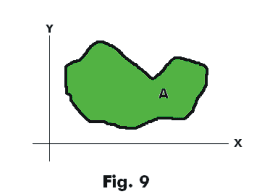


where A is the area of the figure. See Fig. 9.
Centroid of a volume or solid. The coordinates of the centroid of a volume or solid are given by



where V is the volume.
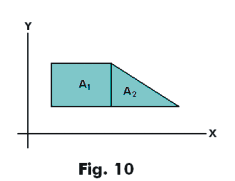
Finding the centroid of an area or volume when the centroids of component
parts are known. Sometimes we may wish to find the centroid of a figure or solid consisting
of component parts with known centroids. Suppose, for example, that an area A consists of two
parts A1 and A2, with centroids at
![]() and
and
![]() respectively. See Fig. 10. It follows
from 9) above that
respectively. See Fig. 10. It follows
from 9) above that
![]()
![]()
and thus
![]()
![]()
Similarly, in the case of volumes,
![]()
![]()
![]()
where the volume V consists of two portions, V1 and
V2, with centroids at
![]() and
and
![]() respectively.
respectively.
Example 1. The density of a certain rod a foot long varies directly as the square of the distance from one end. Find the center of gravity.
Solution. Place the rod on the x-axis, one end at the origin so that ρ = kx2.

![]()


where a is the length of the rod.
Example 2. Find the center of gravity of that area cut from the parabola y2 = 4px by the latus rectum. See Fig. 11.
Solution. Because of symmetry
![]() = 0.
= 0.

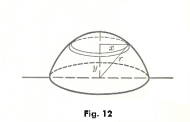
Example 3. Find the center of gravity of a homogeneous hemisphere of radius r.
Solution. The center of gravity will lie on the diameter perpendicular to the base at a distance
![]() above the base. See Fig. 12.
above the base. See Fig. 12.

Moment of inertia. The term “moment of inertia” is applied to different quantities in physics and engineering which are mathematically similar but different in nature. In some cases the term is inappropriate because the quantity has nothing to do with inertia. The quantity that is most appropriately called the moment of inertia is encountered in dynamics in connection with rotating bodies. In various engineering problems, in particular in the analysis of the distribution of stress over the cross-sectional areas of beams, columns, machine parts, etc. a quantity called the “moment of inertia” of an area is encountered which has nothing to do with mass or inertia and would be more appropriately called something else. Because of this situation one cannot give a single definition of “moment of inertia”. The quantities called moments of inertia fall into two groups: 1. the areal moments of inertia connected with computing stresses over cross-sectional areas. 2. the mass moment of inertia connected with the analysis of rotating bodies. We will treat the group concerned with finding cross-sectional stresses first. It is concerned with areas, plane figures.
I Areal moments of inertia.
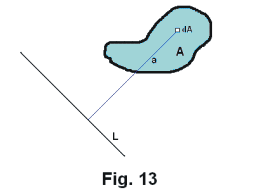
Moment of inertia of an area. The moment of inertia of an area A is given by
![]()
where a is the distance of a differential element dA from an axis L about which the moment of inertia is desired. See Fig. 13. The axis can be a line in the plane of area A or it can be a line perpendicular to the plane. See Fig. 14. If it is perpendicular to the plane the moment of inertia is called the polar moment of inertia.
Rectangular Moments of Inertia. If an area A is referred to an x-y coordinate system the moments of inertia with respect to the x and y axes are
![]()
![]()
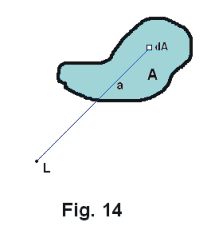
where the element dA corresponds to the point (x, y). These are called the rectangular moments of inertia. See Fig. 15.
Polar Moment of Inertia. The moment of inertia about the pole O (i.e. z-axis of an x-y-z coordinate system) is
![]()
where r is a radius vector from the pole O to the element dA [which corresponds to point (x, y)]. See Fig. 15. Since x2 + y2 = r2 it can be seen that
16) Jz = Ix + Iy
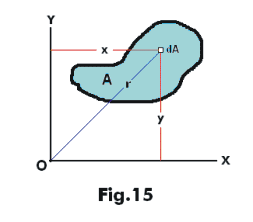
The moment of inertia of an area is a purely mathematical property of the area and in itself has no physical significance.
Radius of gyration. The radius of gyration kL about some axis L is defined by

where IL is the moment of inertia about L. Similarly, the radius of gyration kz about some pole z is defined by

If the entire area were concentrated at a point whose distance from the axis (or pole) is equal to the radius of gyration k, the moment of inertia of the concentrated area would be equal to that of the original area. It is a mathematical quantity used in connection with studying the strength of columns, beams, etc.
Parallel-Axis theorem. If Ic is the moment of inertia of an area A with respect to a line through its centroid and Is is the moment of inertia with respect to a line S parallel to this line, then
18) Is = Ic + Ad 2
where d is the distance between the two lines.
Equation 18) also holds for polar moments of inertia i.e.
Js = Jg + Ad 2.
Composite areas. When a composite area can be divided into a group of simple areas, such as rectangles, triangles, and circles, the moment of inertia of the composite area about a particular axis is the sum of the moments of inertia of the simple areas, each about this same axis. If a composite area has a “hole” in it, the moment of inertia of the net composite area is equal to the moment of inertia of the gross area including the “hole” minus the moment of inertia of the “hole”, each moment of inertia being taken about the same axis.
Faires & Chambers. Analytic Mechanics. p. 213
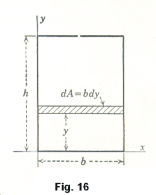
Example 1. Compute the moment of inertia of the area of a rectangle with respect to one side.
Solution. Choosing axes as shown in Fig. 16, we have
dA = b dy
y2dA = y2b dy

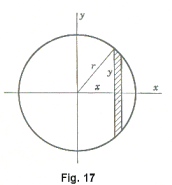
Example 2. Compute the moment of inertia of the area of a circle with respect to a diameter.
Solution. See Fig. 17.
dA = 2y dx
![]()

II Moments of inertia of masses (i.e. mass moment of inertia)
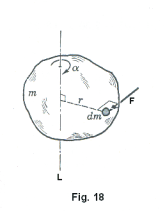
The moment of inertia of a body with respect to some particular line or axis is a property of the body associated with rotational movement about that line or axis. Consider the body shown in Fig. 18 rotating about axis L. Any torque M applied to the body causes rotational acceleration. The moment of inertia of a body is a measure of the resistance that the body offers to any change in its angular velocity in the same way that the mass of the body is a measure of the resistance that the body offers to any change in its linear velocity. In fact, the moment of inertia, I, plays the very same role in angular motion that mass plays in linear motion. For example, the angular momentum of a rotating body is given by Iω, (where ω is the angular velocity) while, in analogy, linear momentum is given by mv. A rotating body maintains a constant angular momentum unless acted upon by a torque just as in linear motion a moving body maintains a constant linear momentum unless acted upon by some force. In angular motion the relationship between torque M, moment of inertia I, and angular acceleration α, is M = Iα in analogy to the formula F = ma for linear motion. The formula for the kinetic energy in angular motion is K.E = ½ Iω2 in analogy to the formula K.E. = ½ mv2 for linear motion.
Def. Moment of inertia with respect to an axis. The moment of inertia of a body with respect to an axis is given by
![]()
where r is the distance of a differential element of mass dm from the axis and integration takes place over the entire body. See Fig. 18.
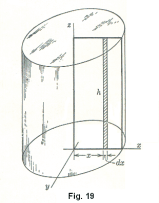
Example. Find the moment of inertia of a solid circular cylinder of radius r, height h, and density δ about its axis of revolution.
Solution. A solid cylinder can be generated by revolving a rectangle about one side as shown in Fig. 19. The value of I can be computed by the cylindrical shell method. The strip shown in the figure generates a cylindrical shell for which
dm = δ·2πxh dx .

This can be conveniently expressed in terms of the mass m of the cylinder. Since m = πr2hδ, we have
I = ½ mr2 .
Another quantity called a “moment of inertia” is the following:
Def. Moment of inertia with respect to a plane. The moment of inertia of a body with respect to a plane is given by
![]()
where r is the distance of a differential element of mass dm from the plane and integration takes place over the entire body.
This quantity has no physical significance. It is useful in some problems primarily as an aid to the calculation of the moment of inertia with respect to an axis.
Connection between the moment of inertia with respect to an axis and the moment of inertia with respect to a plane. The moment of inertia of a body with respect to the y-z plane is given by
![]()
The moment of inertia of a body with respect to the x-z plane is given by
![]()
The moment of inertia of a body with respect to the z axis is given by
![]()
where r is the distance from dm to the z-axis. Since r2 = x2 + y2
![]()
Similar expressions can be written for the other two axes i.e.
Ix = Ixy + Ixz
Iy = Ixy + Iyz .
Stated in words: The sum of the moments of inertia of a mass with respect to two planes at right angles to each other is equal to the moment of inertia of the mass with respect to the axis formed by the intersection of the planes.
Product of inertia. In a few problems of advanced mechanics the integrals
![]()
are useful. These integrals are called the products of inertia of the mass m. They may be either positive or negative. In general, a three-dimensional body has three moments of inertia about the three mutually perpendicular axes and three products of inertia about the three coordinate planes. For an unsymmetrical body of any shape it is found that for a given origin of coordinates there is one orientation of axes for which the products of inertia vanish. These axes are called the principal axes of inertia. The corresponding moments of inertia about these axes are known as the principal moments of inertia and include the maximum possible value and the minimum possible value.
Meriam. Mechanics. Vol. 1 (Statics). p.318
Radius of gyration. The radius of gyration k of a mass m about some axis is defined by

If the entire mass were concentrated at a point whose distance from the axis is equal to the radius of gyration k, the moment of inertia of the concentrated mass would be equal to that of the original mass.
Transfer of Axes. If the moment of inertia of a body is known about a centroidal axis, it may be determined easily about any parallel axis using the Parallel-Axis theorem.
Parallel-Axis theorem. If Ic is the moment of inertia of a body of mass m with respect to a line through its centroid and Is is the moment of inertia with respect to a line S parallel to this line, then
18) Is = Ic + md2
where d is the distance between the two lines.
Composite bodies. The moment of inertia of a composite body is the sum of the moments of inertia of the parts of the body, the same axis of reference being used for each part. If a body has a hole drilled in it, the moment of inertia of the drilled body is equal to the moment of inertia of the original body minus the moment of inertia of the removed material, each moment of inertia being about the same axis.
Faires & Chambers. Analytic Mechanics. p. 234
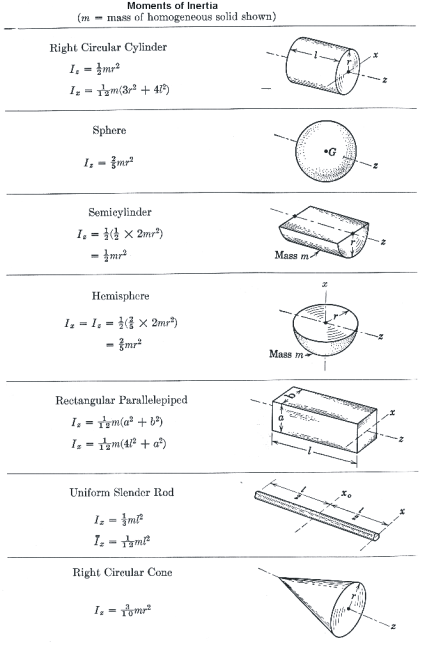
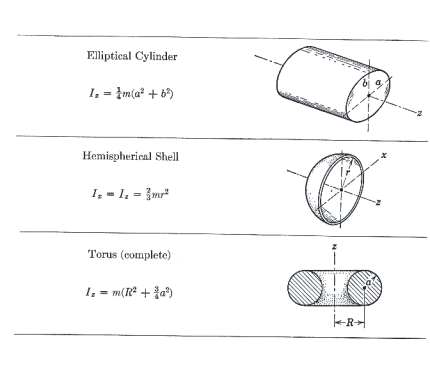
References.
Middlemiss. Differential and Integral Calculus.
Oakley. The Calculus.
Faires & Chambers. Analytic Mechanics.
Meriam. Mechanics. Vol. 1 (Statics).
Jesus Christ and His Teachings
Way of enlightenment, wisdom, and understanding
America, a corrupt, depraved, shameless country
On integrity and the lack of it
The test of a person's Christianity is what he is
Ninety five percent of the problems that most people have come from personal foolishness
Liberalism, socialism and the modern welfare state
The desire to harm, a motivation for conduct
On Self-sufficient Country Living, Homesteading
Topically Arranged Proverbs, Precepts, Quotations. Common Sayings. Poor Richard's Almanac.
Theory on the Formation of Character
People are like radio tuners --- they pick out and listen to one wavelength and ignore the rest
Cause of Character Traits --- According to Aristotle
We are what we eat --- living under the discipline of a diet
Avoiding problems and trouble in life
Role of habit in formation of character
Personal attributes of the true Christian
What determines a person's character?
Love of God and love of virtue are closely united
Intellectual disparities among people and the power in good habits
Tools of Satan. Tactics and Tricks used by the Devil.
The Natural Way -- The Unnatural Way
Wisdom, Reason and Virtue are closely related
Knowledge is one thing, wisdom is another
My views on Christianity in America
The most important thing in life is understanding
We are all examples --- for good or for bad
Television --- spiritual poison
The Prime Mover that decides "What We Are"
Where do our outlooks, attitudes and values come from?
Sin is serious business. The punishment for it is real. Hell is real.
Self-imposed discipline and regimentation
Achieving happiness in life --- a matter of the right strategies
Self-control, self-restraint, self-discipline basic to so much in life